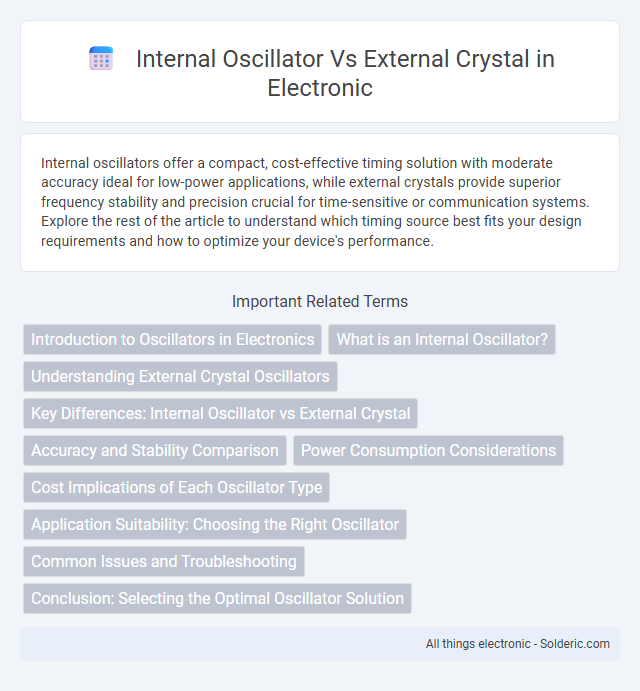Internal oscillators offer a compact, cost-effective timing solution with moderate accuracy ideal for low-power applications, while external crystals provide superior frequency stability and precision crucial for time-sensitive or communication systems. Explore the rest of the article to understand which timing source best fits your design requirements and how to optimize your device's performance.
Comparison Table
| Feature | Internal Oscillator | External Crystal |
|---|---|---|
| Accuracy | Low to Moderate (+-1% to +-5%) | High (+-20 ppm or better) |
| Stability | Less Stable, Affected by Temperature & Voltage | Highly Stable Across Temperature Variations |
| Cost | Lower Cost, Integrated on Chip | Higher Cost, Requires External Component |
| Size | Compact, No Extra Components Needed | Larger, Requires Crystal and Load Capacitors |
| Power Consumption | Lower Power Consumption | Higher Power Consumption |
| Startup Time | Fast Startup | Longer Startup Time |
| Frequency Range | Limited, Typically Fixed Frequencies | Wide Frequency Range, Customizable |
| Noise & Jitter | Higher Noise and Jitter | Lower Noise and Jitter |
| Application Suitability | Suitable for Low-Cost, Less Critical Timing | Ideal for Precision Timing and Communication |
Introduction to Oscillators in Electronics
Oscillators in electronics generate clock signals essential for timing and synchronization in digital circuits. Internal oscillators are integrated within microcontrollers, offering convenience and reduced component count with moderate accuracy. External crystals provide highly stable and precise frequency references, crucial for applications requiring tight timing tolerances and low frequency drift.
What is an Internal Oscillator?
An internal oscillator is a built-in timing source within a microcontroller or integrated circuit that generates clock signals without requiring external components. It offers convenience and cost savings by eliminating the need for an external crystal or resonator, though it may provide less precision and stability compared to external oscillators. Your choice between an internal oscillator and an external crystal depends on the required accuracy, power consumption, and application constraints.
Understanding External Crystal Oscillators
External crystal oscillators provide highly accurate and stable clock signals essential for precise timing applications in microcontrollers and embedded systems. These oscillators use quartz crystals that exhibit piezoelectric properties, producing a consistent frequency with minimal drift due to temperature variations and aging. Unlike internal oscillators, external crystals offer superior frequency accuracy, lower jitter, and improved noise immunity, making them ideal for communication protocols, real-time clocks, and precise digital signal processing tasks.
Key Differences: Internal Oscillator vs External Crystal
Internal oscillators provide built-in clock sources with moderate accuracy and ease of use, ideal for low-cost and low-power applications, while external crystals offer significantly higher frequency stability and precision, essential for timing-critical tasks. Internal oscillators typically have frequency tolerances around +-1% to +-5%, whereas external crystals achieve tolerances as tight as +-20 ppm or better, making them suitable for communication protocols and precise timekeeping. You should choose an internal oscillator for simplicity and cost savings, but rely on an external crystal when accuracy and stability directly impact system performance.
Accuracy and Stability Comparison
External crystals provide higher accuracy and superior stability compared to internal oscillators due to their precise quartz resonator design, minimizing frequency drift over temperature and time. Internal oscillators are more susceptible to variations caused by temperature fluctuations and power supply noise, resulting in lower frequency accuracy and stability. Choosing an external crystal enhances your system's timing precision, especially in applications requiring reliable and consistent clock signals.
Power Consumption Considerations
Internal oscillators generally consume less power compared to external crystals, making them ideal for low-power applications and battery-operated devices. External crystals, while offering higher frequency stability and accuracy, typically require additional circuitry that increases overall power consumption. Designers must balance power efficiency against timing precision when choosing between internal oscillators and external crystals.
Cost Implications of Each Oscillator Type
Internal oscillators generally incur lower costs due to their integrated design and reduced component count, leading to simplified circuit layouts and fewer external parts. External crystals, while more expensive upfront because of the crystal component and additional circuitry, offer superior frequency stability and accuracy, which can reduce downstream costs related to calibration and performance issues. Your choice between internal oscillator and external crystal should consider the balance between initial cost savings and the potential benefits of enhanced precision and reliability provided by external crystals.
Application Suitability: Choosing the Right Oscillator
Internal oscillators provide moderate frequency accuracy and low cost, making them suitable for applications with relaxed timing requirements such as simple microcontroller tasks or battery-powered devices. External crystals offer high stability and precision, essential for communication systems, real-time clocks, and applications demanding precise timing synchronization. Selecting between these oscillators depends on balancing cost, power consumption, and timing accuracy needs specific to the application's performance criteria.
Common Issues and Troubleshooting
Internal oscillators often face frequency stability issues caused by temperature variations and supply voltage fluctuations, leading to timing inaccuracies in microcontroller applications. External crystals provide superior frequency precision but can suffer from startup failures or oscillation halts due to improper load capacitance values, PCB layout errors, or damaged crystal components. Troubleshooting involves verifying power supply stability, checking circuit and layout design for noise or improper grounding, and measuring oscillation frequency with an oscilloscope to identify signal integrity problems.
Conclusion: Selecting the Optimal Oscillator Solution
Choosing between an internal oscillator and an external crystal depends on your project's requirements for precision, cost, and stability. Internal oscillators offer cost-effective, space-saving solutions with moderate accuracy, suitable for less timing-critical applications. External crystals provide superior frequency stability and accuracy, making them ideal for high-performance or timing-sensitive designs where reliable oscillation is crucial.
Internal oscillator vs External crystal Infographic

 solderic.com
solderic.com